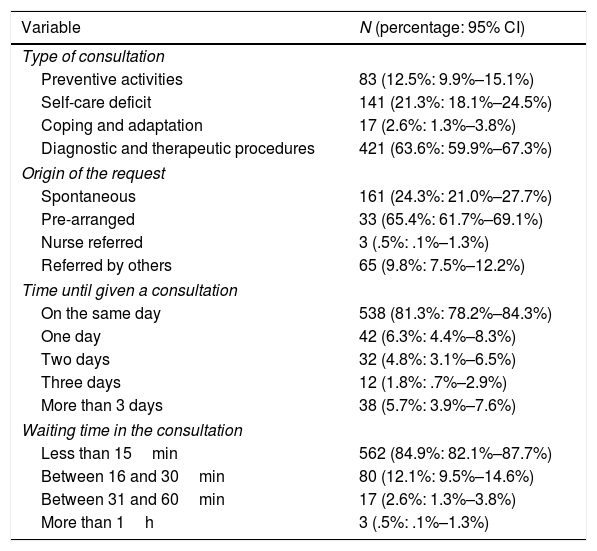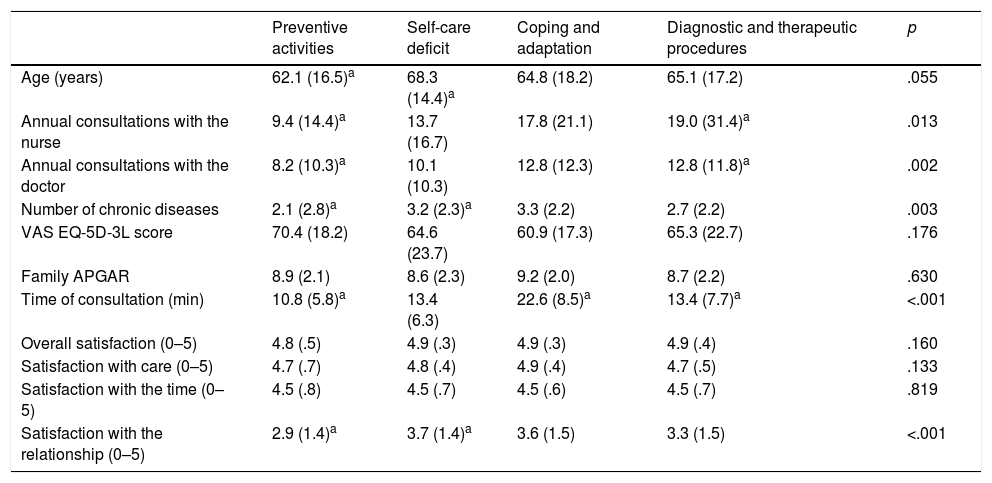To analyse the characteristics of primary care nurse consultation and to identify the factors associated with different types of activity.
MethodA cross-sectional multicentre observational study in 23 health centres (Community of Madrid), on 164 different nurses. The consultation was classified according to a consensus proposal in: “preventive activities” (PA), “self-care deficit” (SD), “coping and adaptation” (CA) and “diagnostic and therapeutic procedures” (DTP). Sociodemographic characteristics, health needs, and consultation characteristics were collected. A bivariate inferential analysis was made, and explanatory multivariate models were constructed.
ResultsOf the total consultations 63.6% (95% CI: 59.9–67.3%) were classified as DTP. The consultation was directly requested by the patient in 24.3% (95% CI: 21.0–27.7%) of the cases. There were no differences in the type of consultations by gender (p=.858), or for immigrants (p=.428). Subjects from higher social classes more frequently attended PA consultations (p=.007). There were no other differences in accessibility. The DTP consultations related to previous hospitalizations (OR: 1.191, 95% CI: 1.088–1.304), or the previous use of services (nurse consultation OR: 1.002, 95% CI: 1.000–1.003, medical consultation OR: 1.003, 95% CI: 1.000–1.006).
ConclusionsThe nurse consultation is mainly aimed at carrying out procedures and previously arranged consultation prevails over patient demanded consultation. No inequities in accessibility were detected, but the type of care for different social groups was not homogeneous.
Analizar las características de la consulta enfermera en Atención Primaria e identificar los factores asociados a los diferentes tipos de actividad.
MétodoEstudio observacional multicéntrico transversal sobre 662 consultas de 164 enfermeras diferentes (23 centros de salud, Comunidad de Madrid). La consulta se clasificó según una propuesta de consenso en: «actividades de prevención» (AdP), «déficit de autocuidados» (DA), «afrontamiento y adaptación» (AyA) y «procedimientos diagnósticos y terapéuticos» (PDyT). Se recogieron características sociodemográficas, de necesidad en salud y relativas a la consulta. Se hizo un análisis inferencial bivariante y se construyeron modelos multivariantes explicativos.
ResultadosEl 63,6% (IC del 95%: 59,9-67,3%) de las consultas fueron PDyT. En el 24,3% (IC del 95%: 21,0-27,7%) de los casos la consulta era a demanda. No hubo diferencias en el tipo de consultas por género (p=0,858), ni para inmigrantes (p=0,428). Los sujetos de clases sociales superiores ocuparon con más frecuencia consultas de AdP (p=0,007). No había otras diferencias en accesibilidad. Las consultas de PDyT se relacionaron con la existencia de hospitalizaciones previas (OR: 1,191; IC del 95%: 1,088-1,304), o el uso previo de servicios (consulta enfermera OR: 1,002, IC del 95%: 1,000-1,003; consulta médica OR: 1,003, IC del 95%: 1,000-1,006).
ConclusionesLa consulta enfermera en nuestro medio se dirige preferentemente a la realización de procedimientos y predomina la consulta autoconcertada respecto a la demanda. No se detectan inequidades en la accesibilidad, pero el tipo de atención para diferentes grupos sociales no fue homogéneo.










